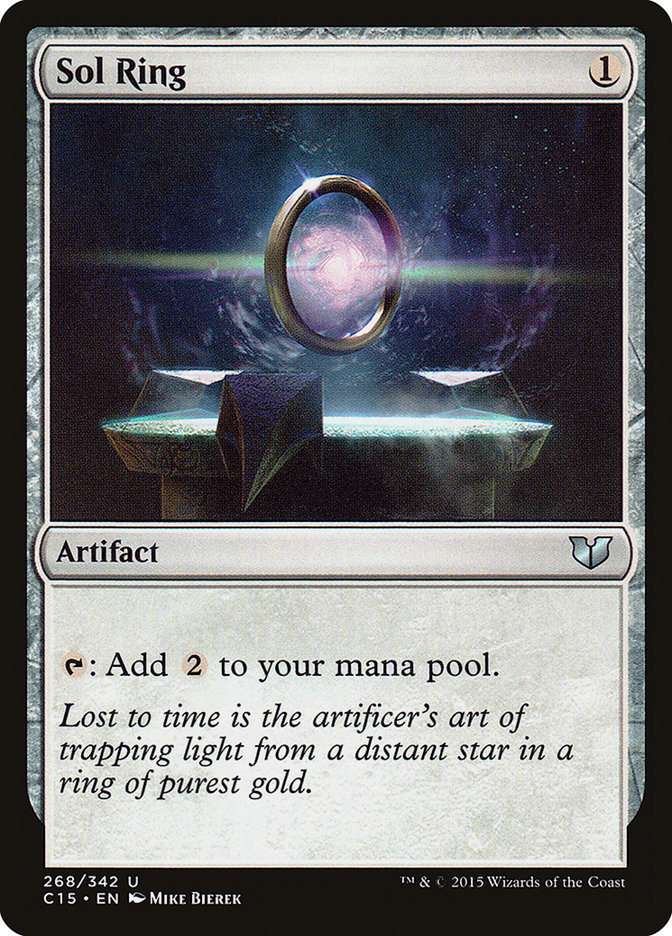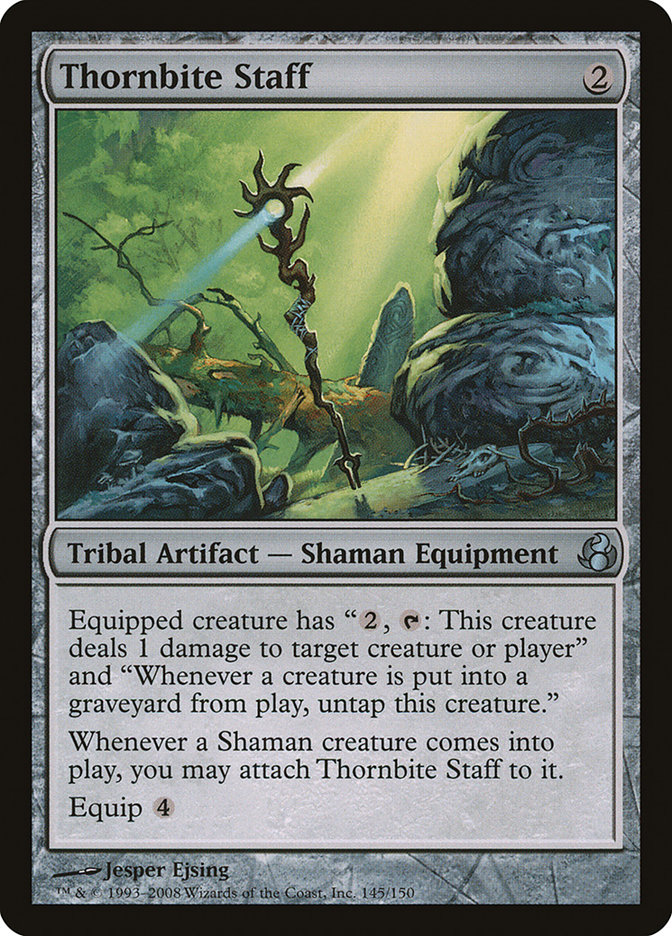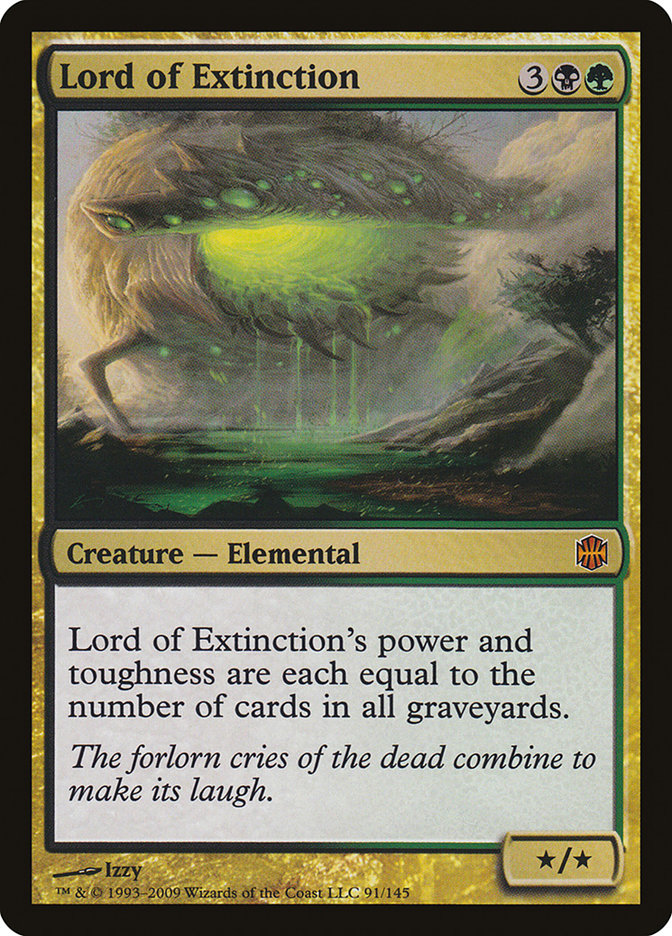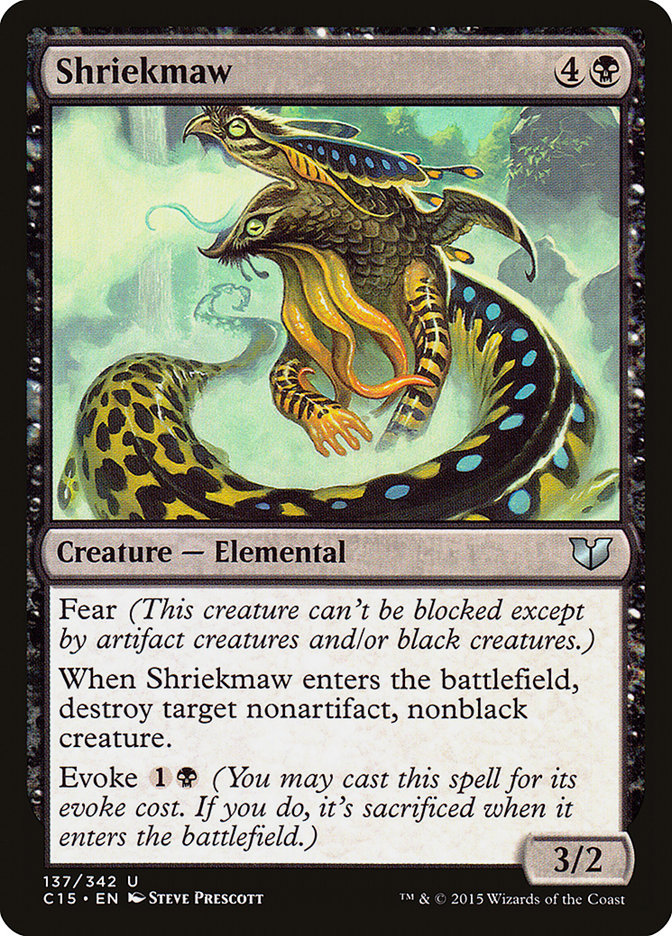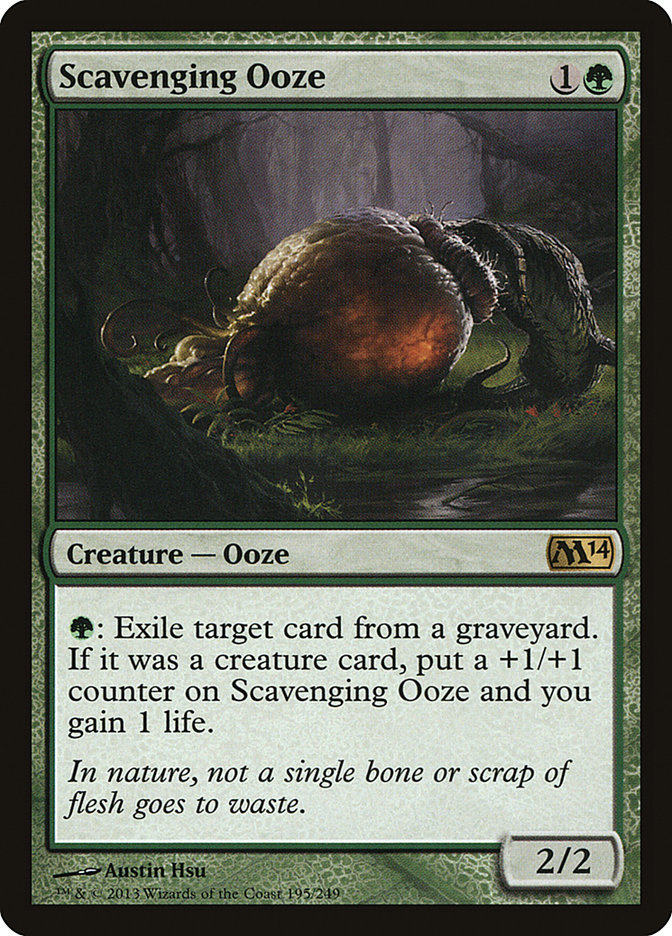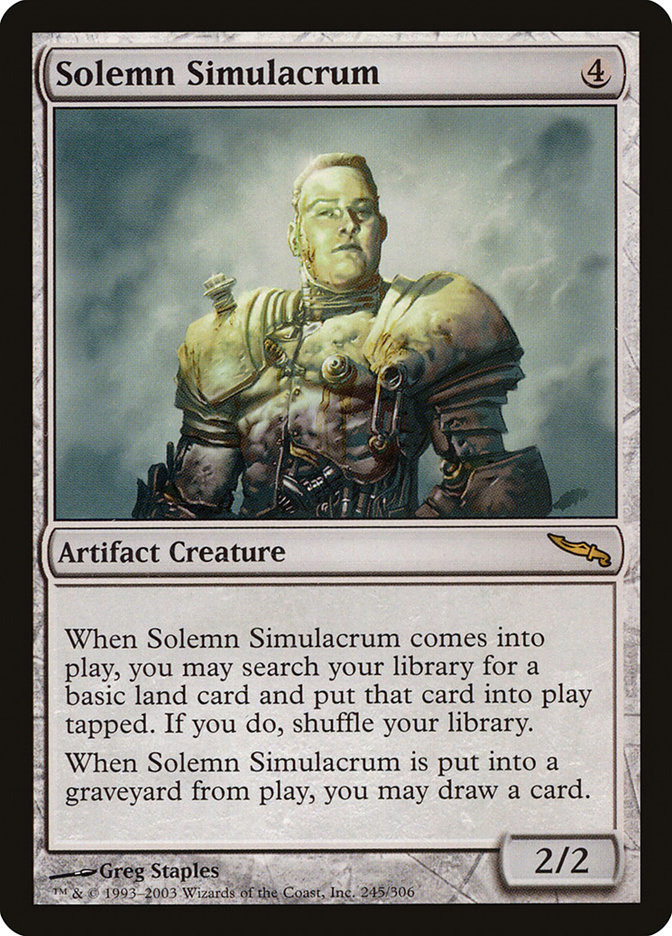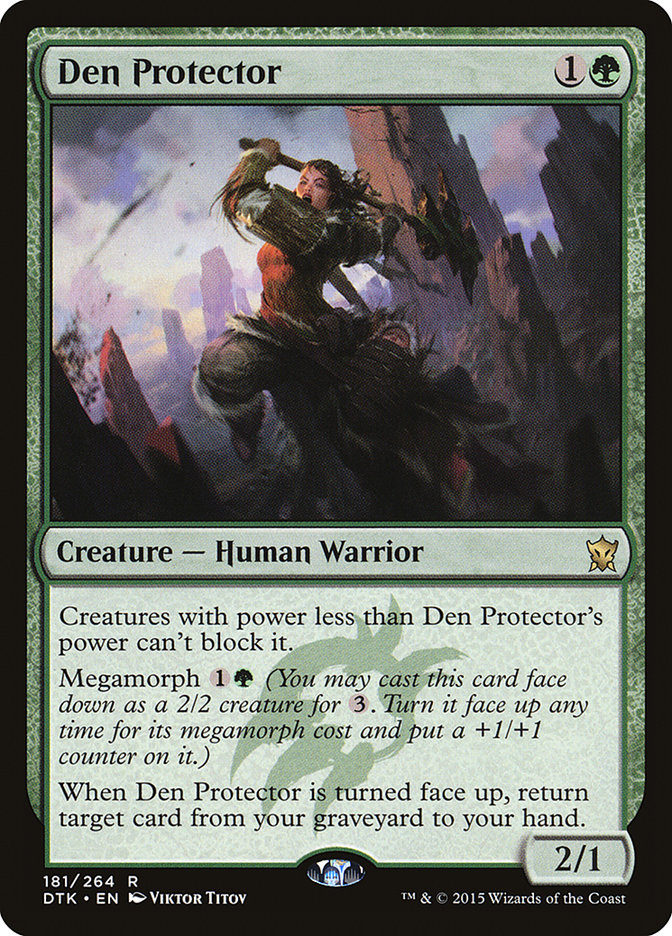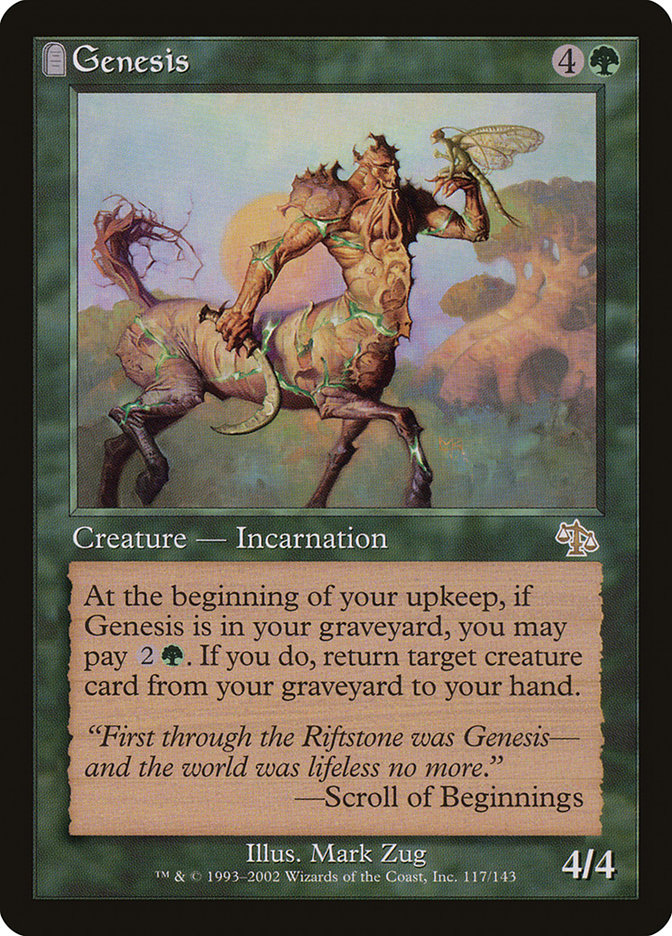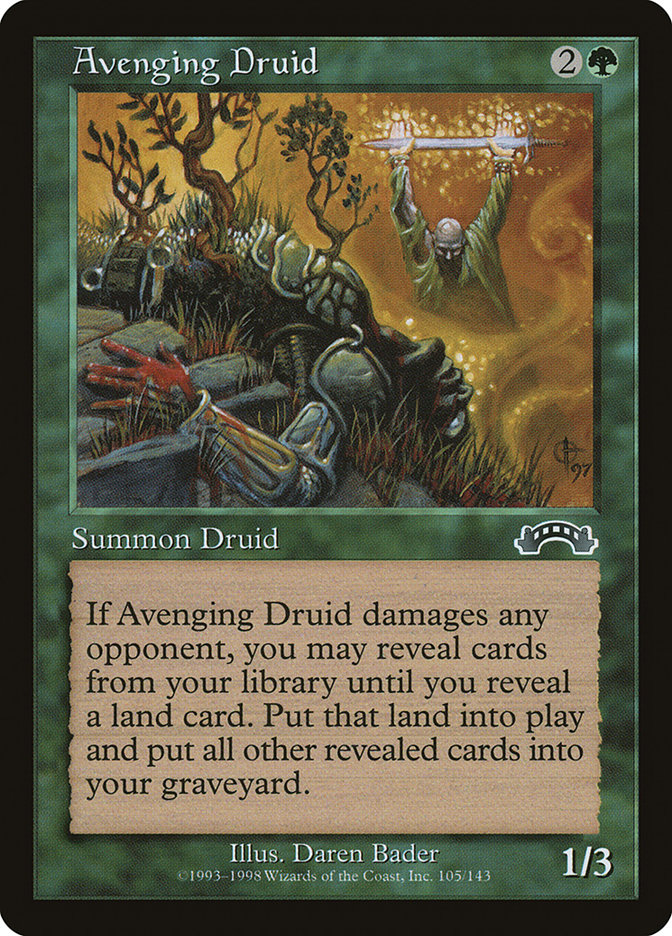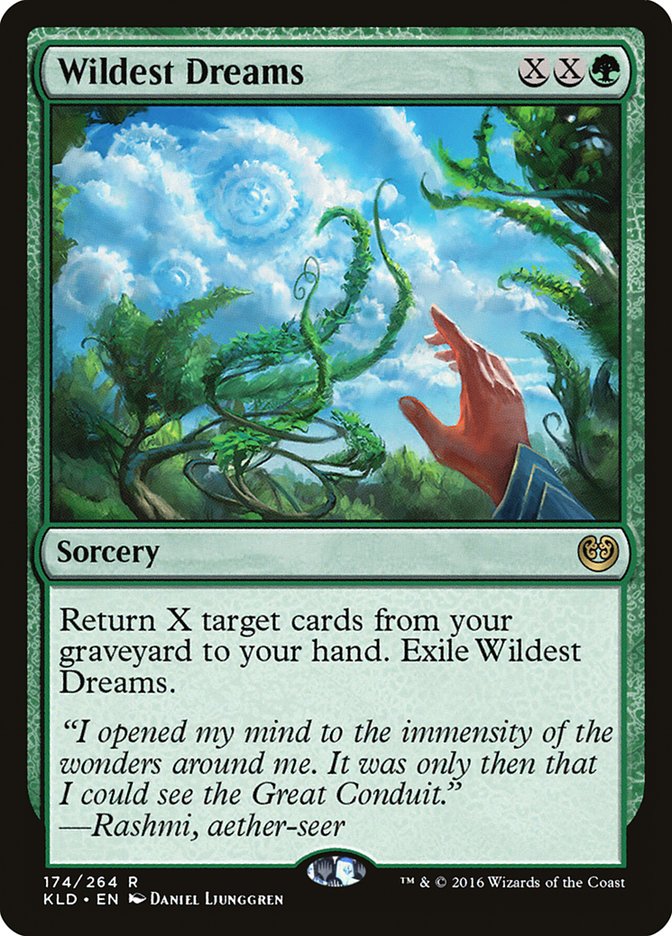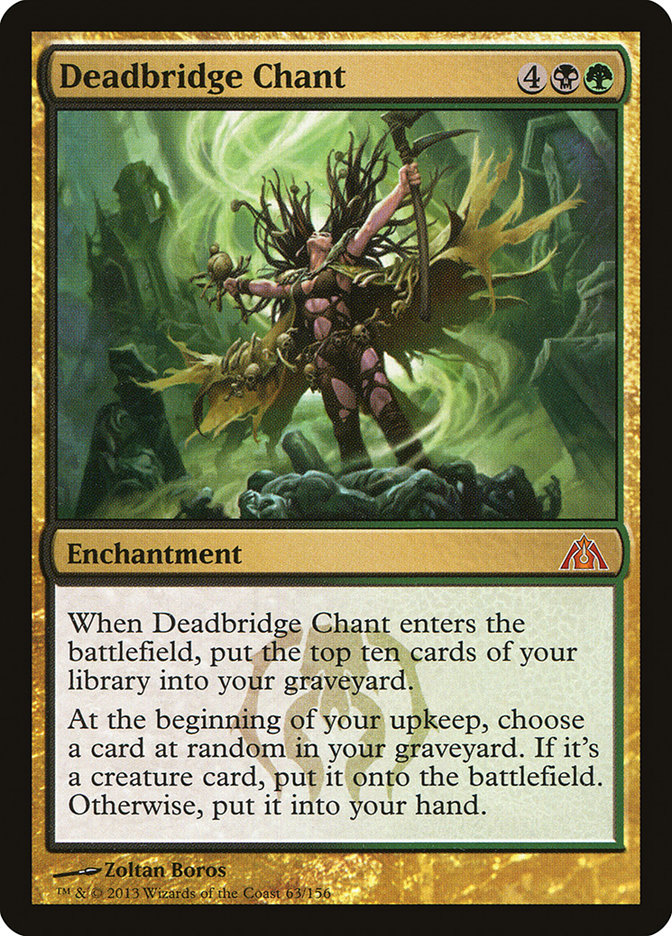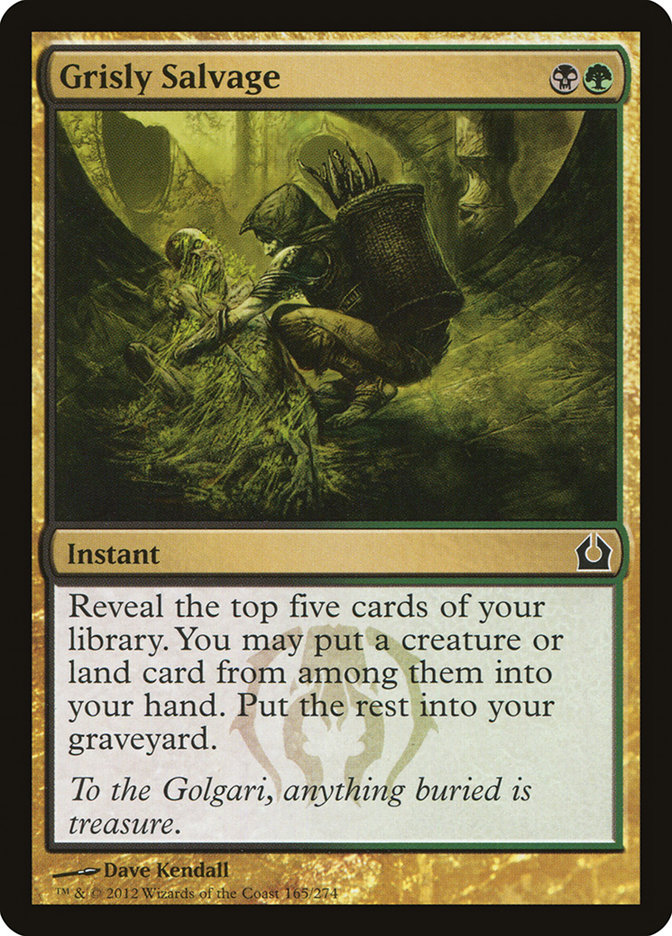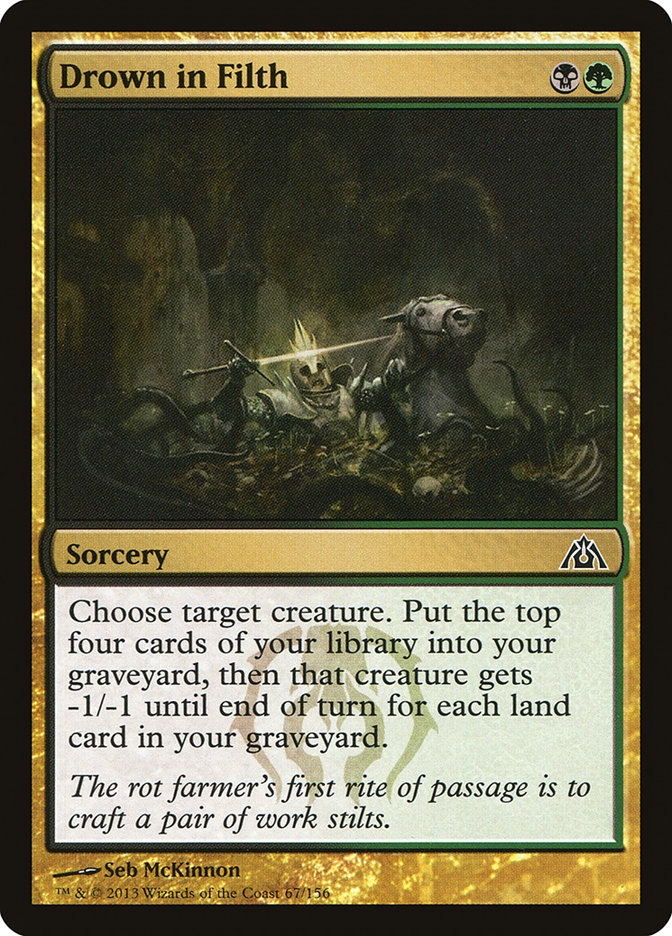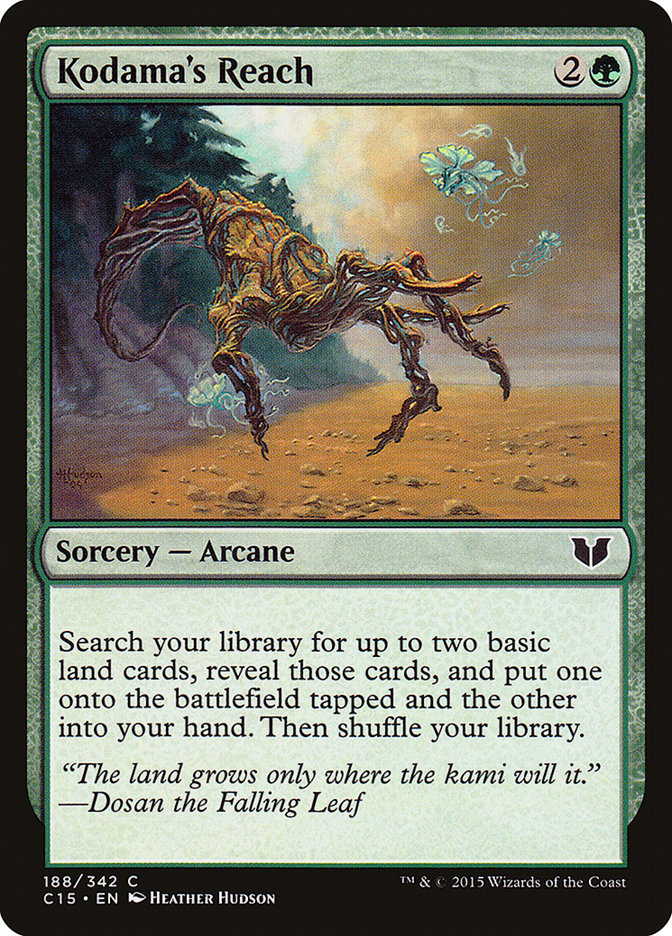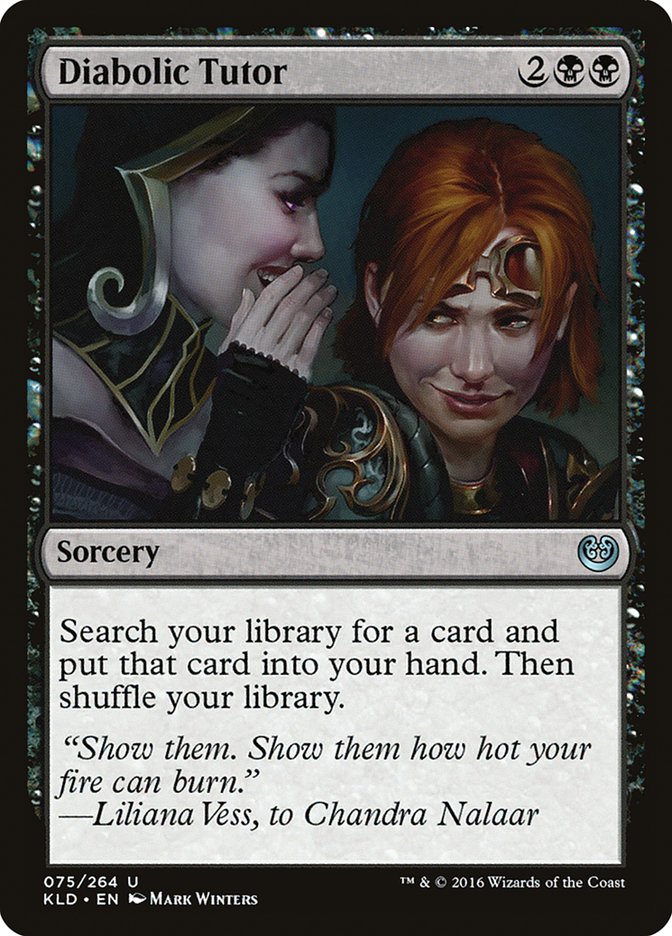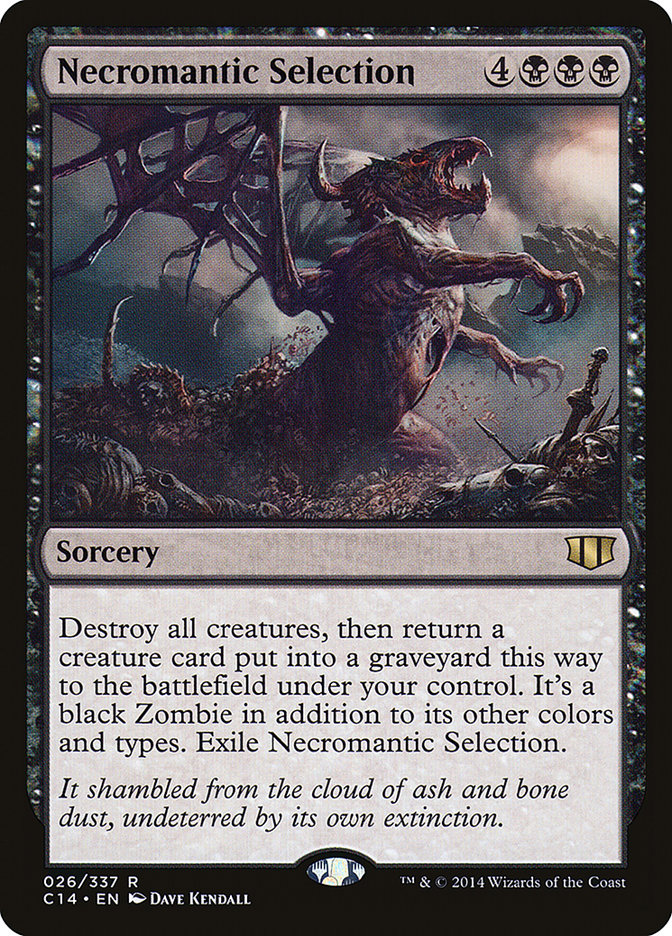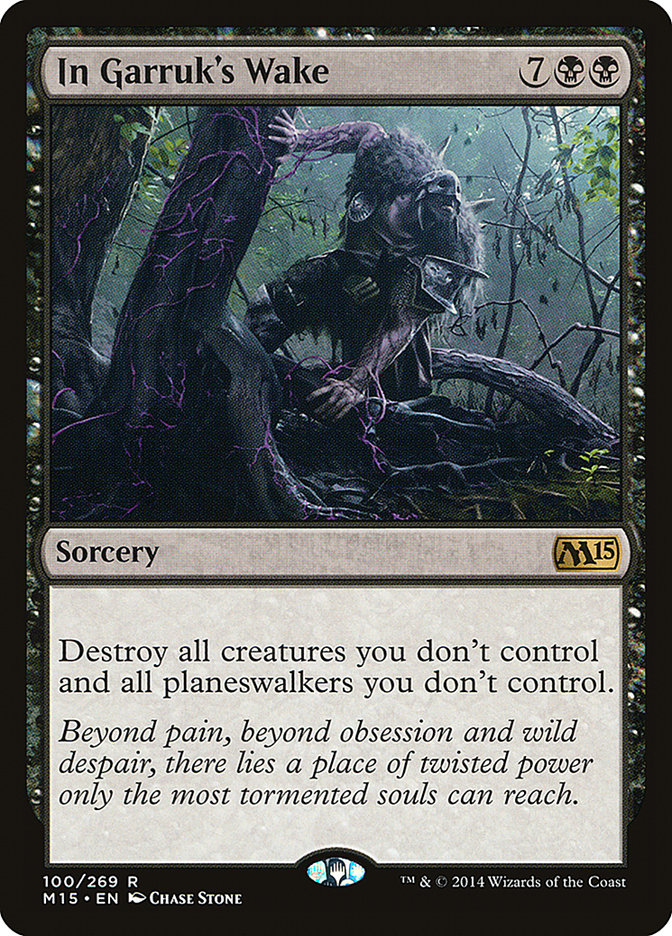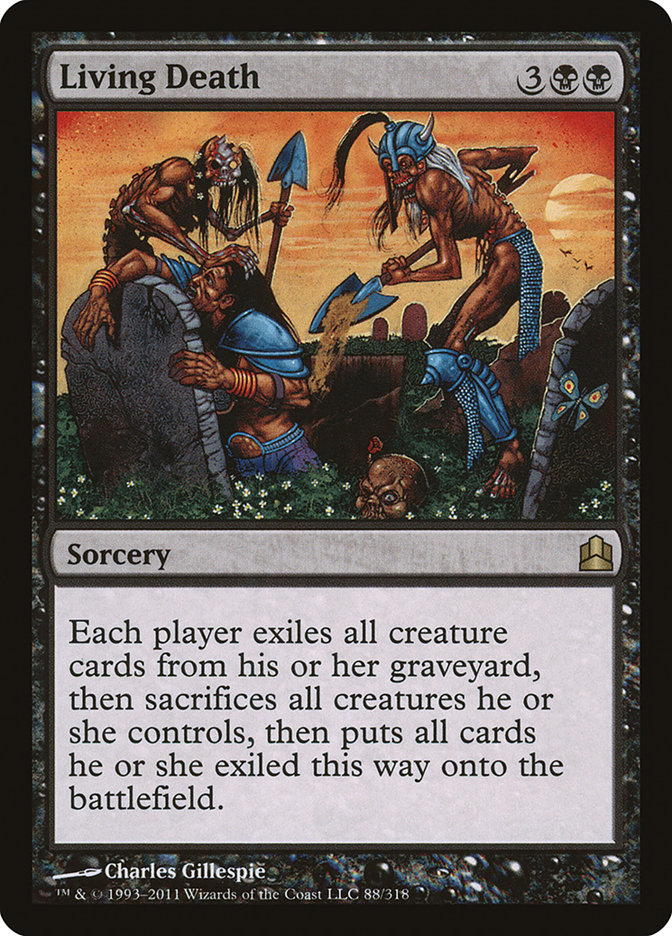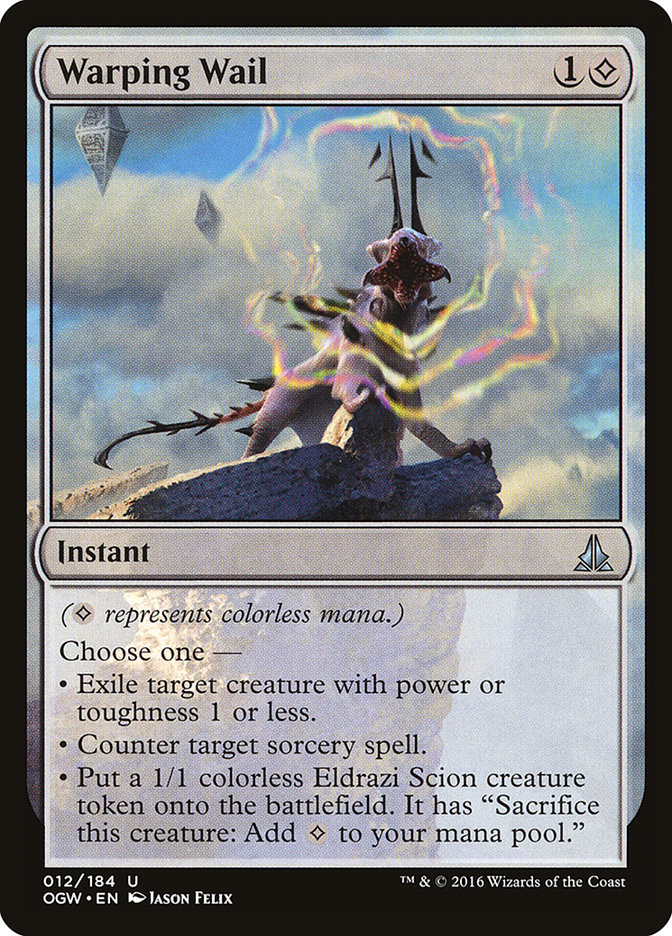Dear Azami,
Ever since Shadows over Innistrad came out, I’ve been trying to make a The Gitrog Monster deck work. Sometimes I feel like I’m getting close, but then I start playing it and I get overrun before I can do anything. I know there are several good cards I could add (Crucible of Worlds; Azusa, Lost but Seeking; Oracle of Mul Daya) but they’re all fairly expensive – I’d like to spend $40-$50 and get more than just one or two cards. I’d also like to add Nissa, Vital Force from Kaladesh depending on where the price ends up, but other than that I feel like I’ve hit a wall. Any ideas?
Here’s my deck:
Commander:
The Gitrog Monster
Creatures (27):
Groundskeeper
Sylvan Safekeeper
Devoted Druid
Golgari Thug
Hermit Druid
Noose Constrictor
Sakura-Tribe Elder
Satyr Wayfinder
Courser of Kruphix
Eternal Witness
Nyx Weaver
Quillspike
Reclamation Sage
Shambling Shell
Stinkweed Imp
Tilling Treefolk
Centaur Vinecrasher
Jarad, Golgari Lich Lord
Mazirek, Kraul Death Priest
Skirge Familiar
Titania, Protector of Argoth
Greenwarden of Murasa
Realm Seekers
World Breaker
Terastodon
Decimator of the Provinces
Ulamog, the Infinite Gyre
Planeswalker (1):
Vraska the Unseen
Artifacts (5):
Zuran Orb
Lightning Greaves
Swiftfoot Boots
Horn of Greed
Whispersilk Cloak
Enchantments (5):
Burgeoning
Crop Sigil
Exploration
Squandered Resources
Nature’s Revolt
Sorceries (14):
Animist’s Awakening
Raven’s Crime
Edge of Autumn
Exsanguinate
Life from the Loam
Regrowth
Rite of Consumption
Far Wanderings
Natural Balance
Splendid Reclamation
Worm Harvest
Decree of Pain
Ezuri’s Predation
Praetor’s Counsel
Instants (7):
Crop Rotation
Darkblast
Constant Mists
Grapple with the Past
Harrow
Putrefy
Sudden Reclamation
Lands (40):
Barren Moor
Blasted Landscape
Blighted Woodland
Command Tower
Dakmor Salvage
Drownyard Temple
Evolving Wilds
12 Forests
Foul Orchard
Ghost Quarter
Golgari Rot Farm
Grasslands
Jund Panorama
Polluted Mire
Rocky Tar Pit
Slippery Karst
Spawning Bed
6 Swamps
Tainted Wood
Tectonic Edge
Temple of the False God
Terramorphic Expanse
Timberland Ruins
Tranquil Thicket
Thanks,
Ryan
I see where this is going, sort of, but it’s hard to be sure – there are these combo-flavored elements that are supposed to work together, like the discard outlets and dredge cards plus Splendid Reclamation and the Squandered Resources / Natural Balance engine that made the Mirage-era ProsBloom combo deck so very, very obnoxious to play against, but then there are these midrange creatures and control cards that want to play a fair game, and then there’s stuff like Devoted Druid / Quillspike and Rite of Consumption / Jarad, Lich Lord that imply you’re trying to combo out in entirely different ways.
I’m not a fan of combo in Commander, though I understand that this makes me a ridiculously stuffy purist. Plenty of decks are built with a two-card “I Win!” condition just to hedge their bets against other combo players, but that’s not what I want to try to accomplish here and I think pushing for fast games or cheap endings like that erodes the value of your Commander. The Gitrog Monster wants to play a longer game and take advantage of those card-draw triggers, so I want to strengthen the midrange and control aspects of the deck while slicing out the combo and dredge elements entirely. (Well, except for Life from the Loam, where the dredge part of the card is basically incidental to us.)
A dredge-based deck is boring, but it’s also fragile in ways I don’t like – one Bojuka Bog can send several turns’ worth of work right out the window, while a handful of Stinkweed Imps, Darkblasts and Shambling Shells basically have blank text boxes except for their dredge numbers here in our 99-card format. In 60-card formats, we’re winning on turn 3, so we aren’t troubled by the fact that they effectively do nothing, but there’s no Survival of the Fittest or something like it here to convert a Shambling Shell into a real card instead of a skipped draw step. Maybe you’ll dredge past a few lands and draw real cards off The Gitrog Monster’s trigger, but this plan is quite loose in addition to being vulnerable to cards everyone already knows they have to play in this format to shut down graveyard recursion.
To shore up the deck’s weaknesses, I’m cutting the open-ended combo parts since they don’t seem essential to the deck and pulling out the dredge engine since it’s unreliable – we can get similar benefits out of cards that actually have text written on them in this format. From there we’ll build up the deck’s midrange game and control elements, keeping to the spirit of your budget even if we don’t keep to the exact limit of it – you said that if you spent $40 or $50, you’d want to get more than just a card or two for that value, so we kept the individual card prices cheap enough that the budget is $75 (only $55 of your dollars when you add in the $20 store credit coupon we offer to all of our participants, so kinda within budget) and no card cost more than $15. Only two cost more than $10, and one of them was one you specifically named. I’d have been content to put a few pricier options in here, like a Craterhoof Behemoth to go next to your Decimator of the Provinces, but we’ll play by your rules here.
The Lands
Your manabase is pretty good, but we can still make a few improvements on the cheap while we’re at it. I assume the 40 lands were mostly chosen so you have the right number go into the graveyard when you mill yourself; my preference of 37 is based more off intuition after long years of playing this format rather than any hard data I’m working from, so I won’t chop any of these slots out just to make your deck confirm to my biases.
Out:

Without an Overgrown Tomb to find, Grasslands and Rocky Tar Pit aren’t quite good enough to play here. I’d think about it if you had a Crucible of Worlds to go with them, but without one they’re just bad basics. You’ll have more than enough ways to put lands into graveyards and trigger your Commander’s draw-a-card clause; we don’t need to go past the B-team and start adding C-listers here. That’s also why we’re cutting Timberland Ruins – which I had to look up, that’s not very common for me, so good job there on remembering your random Odyssey threshold-enabler lands – and I feel much the same way about Spawning Bed here as well. If it were Foundry of the Consuls and made Thopters instead of Eldrazi Scions, I would maybe have considered leaving it be, but as it is I’m not that interested in either and would prefer another cheap two-color land or something that provides actual utility.
In:

We have two more incredibly cheap two-color lands to add, and I’d rather have either of those than a Tainted Wood, even though you do actually have a card that wants you to have a colorless land on the battlefield. In order to cover that contingency, we’re adding an actual Wastes to search for with your various land-search effects so you can have it on demand rather than rely on a Jund Panorama or Blasted Landscape randomly turning up on time. Bojuka Bog is likewise an easy addition to just sneak in here; people mess with their graveyards a lot in this format, so being able to tell them “Stop that!” is very good and worth getting for free out of a land slot. It doesn’t hurt that you can plausibly do it turn after turn thanks to Life from the Loam and The Gitrog Monster – when you really need that effect, it’ll be omnipresent and essentially free once your deck is firing on all cylinders.
The last two utility lands just give us a little bit of extra oomph out of our manabase; Mosswort Bridge’s free spell is an incredibly great value when your Commander is big enough to get you 60% of the way towards its Hideaway trigger by itself, and just like with Bojuka Bog, you can end up in the later stages of the game getting an extra spell turn after turn via Life from the Loam and sacrificing it to The Gitrog Monster, so it’s even better here than it usually would be. You’d mentioned trouble with defense and opponents just rolling you as a problem, so rather than just focus on what it is doing, I wanted a land that could help pay attention to what opponents might do back to you. A little bit of extra defense thanks to Mystifying Maze should go a long way towards preventing incoming attacks in the later stages of the game.
A Yavimaya Hollow would also have been great in this deck, but with a sticker price of near $20 these days, I couldn’t suggest it and keep anywhere near your budget rules. If you find one for trade in somebody’s binder at your local gaming store, I’m sure it would be an excellent addition.
The Artifacts
While almost every deck would be better with a Sol Ring than without it, let’s focus on what you’re actually trying to do here: you have three Equipment intended to keep your Commander from being targeted and two combo-ish cards. I don’t think Whispersilk Cloak is really helping, so that’s going to get the axe, and I don’t think either Zuran Orb or Horn of Greed are actually helping here. Yes, there are decks where Horn of Greed is going to be a vital component to your comboing off. I just don’t think this is one of them, as The Gitrog Monster’s not a big fan of sharing the card advantage. You’ll much prefer the emblem on Nissa, Vital Force instead, so we’ll replace one with the other and not help the other three players at the table quite so much.
Zuran Orb, along with Squandered Resources, is actually the most egregious offender as a combo engine – sacrificing your lands to draw a bunch of cards and then somehow cast Splendid Reclamation and mysteriously kill your opponent appears to be the gameplan here, but I don’t think that game is a very good one. Skirge Familiar plus Exsanguinate is totally a way to win the game once you’ve drawn your deck, but “wanting to draw your deck” is a cardinal sin in this format. Not breaking the format is harder than breaking the format, and in the interests of self-restraint, that Zuran Orb will be cut for another interactive card. In this case, that slot will be going to Nihil Spellbomb so our opponents don’t get away with the same kind of graveyard-recursion shenanigans we’re hoping to in the later stages of the game.
While we’re at it, Whispersilk Cloak will be swapped for this piece of ridiculous Equipment:
We want to have some more creature control in this deck just as a matter of principle to begin with, and it just so happens that The Gitrog Monster is one of those very few commanders with deathtouch built-in. When you have one of those, a Thornbite Staff cannot be very far behind – adding “2: Destroy target creature” to your list of repeatable options is pretty hard to argue against in a format like this one. This is the kind of combo I can actually get behind in Commander, as ultimately it’s rooted in playing fair Magic.
The Creatures
This is the part of the deck I liked the most, and I looked at it the hardest to try to figure out what you were actually trying to accomplish when not using your Commander as if it were a bootleg Yawgmoth’s Bargain. Cards like Nyx Weaver, Tilling Treefolk, and Centaur Vinecrasher told me that we really wanted to play the self-mill recursion / card advantage game with The Gitrog Monster and that I should pay attention to them rather than to the Scourge Familiars and Noose Constrictors that lead us down a dark path. We lose the sense of what you can accomplish with this commander if we try to go broken instead; figuring out how to be powerful while still expressing self-restraint is a far more interesting problem.
With that in mind, I have nine cuts:
Out:


Normally I like one Eldrazi in my deck so that I have protection against milling effects or at least some way to shuffle cards I want back into my deck. I like the option of a Feldon’s Cane-like thing for long games when I want it; I just want the card to have actual text the rest of the time too. That said, it’s actually counterproductive here because your deck wants to build up its graveyard, so I’d sooner cut it than keep it. Marizek, Kraul death Priest doesn’t really seem to fit any other part of the deck except maybe the “creatures plus Decimator of the Provinces” plan that can do fun things with Worm Harvest and a full graveyard, but it’s not actually good, so it doesn’t make the cut. As I said above, I’d want a Craterhoof Behemoth in that slot, but it’s now a $25 card, so it cannot make my suggestion list according to the rules of your budget. Fair enough.
Everything else gets cut for the sin of being a combo card in a deck we’re trying to get to play on the straight and narrow, but their larger sin is that they’re otherwise useless to us. Noose Constrictor will never say anything else besides “Lands in your hand have Cycling: 0” and Quillspike is a three-mana vanilla 1/1 unless you have a Devoted Druid on the table. Golgari Thug is just a do-nothing 1/1 with a weak recursion ability unless we’re dredging, and in all of these cases we just have better things to do.
One slot is being cut to make room for another spell, so we have eight additions to make. First up is the priciest addition I was willing to make to the deck:
$15.99 puts us dangerously near that “two cards for $40” mark that earns your active disinterest, but this is a) a graveyard deck, b) that is both black and green, and c) playing Jarad, Golgari Lich Lord. You’re playing Rite of Consumption to go with that self-resurrecting legendary creature in order to potentially one-shot an opponent from a solid life total, but Lord of Extinction plus Jarad, Golgari Lich Lord is the far stronger two-card combo. Rite of Consumption generally won’t do much in your average game; Lord of Extinction will always be a huge body at an attractive rate that only gets bigger as your self-mill cards come out to play. While this is a little more two-card-combo than I prefer to play, my preferences are not meant to be your limitations – my read of things from this deck is that I think you’ll enjoy this addition and appreciate the late-game utility that being able to assemble your combo provides you with, so in it goes.
Yeah, utility creatures are a little bit boring, but I think they’ll all help fill a role, and as the deck is becoming a bit more midrange, these will be welcome two-for-ones or of vital importance – that Scavenging Ooze alongside your Nihil Spellbomb and your Bojuka Bog (plus Crop Rotation to find it and Life from the Loam to recur it) should be just enough to make sure an opponent who wants to get away with graveyard shenanigans will meet stiff resistance. The removal offered by Shriekmaw and Acidic Slime will help with our overall midrange plans, and with the Shriekmaw specifically, I wanted a card that could be cheap rather than expensive; Duplicant is a more permanent answer and one without any targeting restrictions, but Duplicant will never cost two mana in a pinch. I’d normally start with both at the top of my roster in a deck like this, but I was tight enough on slots (…and budget…) that the Duplicant didn’t make the cut. You may elect to include it if you think that’s where this deck is taking you in the future, but for right now I had to make a painful call and go without it.
More of what the deck is already good at. While I can leave that Sol Ring off without too much worry, as this deck is getting more interested in card advantage and mid-game development, I can’t skip by Solemn Simulacrum here. Meanwhile, Den Protector fits right in with Eternal Witness and Greenwarden of Murasa and so it clearly deserves a slot.
In that same vein of thought, Genesis is perfectly at home here in our deck with a good chunk of self-milling power and an interest in long-game card advantage. Genesis plus the utility creatures I’ve increased in number here will be a strong mid-game plan, and of course it didn’t hurt that Shriekmaw’s evoke ability puts it right back in the graveyard for Genesis to re-buy turn after turn.
Just milling your library as you normally plan to will now help uncover both Jarad and the Lord of Extinction that combos so nicely with it and provide you with a built-in means to recur the Lich Lord – Jarad already possessed that through his land-sacrifice ability, but Genesis can put Lord of Extinction in your hand too. One turn with all three of these cards in the graveyard and enough mana to do whatever you want will put both of them in your hand and activate the sacrifice ability right away, so you needn’t worry about your ability to close a game out in the end… your deck has a certain inevitability, giving you the freedom to make your decisions based on what you can do now rather than worrying about your window to win the game irrevocably closing. So long as you defend yourself and keep playing Magic, a win will eventually appear.
I love the “fair” use of a Hermit Druid in a deck with plenty of basics, so I wanted to pursue that side of things a bit further here rather than play any dredge cards. Avenging Druid is a weird one, part ramp and part self-mill and part card advantage, built as if it were intended to be “the Green Ophidian” back in the day. It never took off like Ophidian did because it wasn’t blue like Ophidian and it didn’t draw cards like Ophidian, but in this deck it will absolutely “draw cards” for you because milling past creatures and spells provides us with extra resources to work with. Raven’s Crime isn’t good enough to draw, after all, even if it fits the deck for you to play it… and the best Genesis is the one that jumps right into your graveyard without ever touching your hand. This was printed when damaging your library with its combat trigger was considered to be a “downside,” but for us it’s actually the prime reason to include the card in the first place – we’d like the free land because it’s free, sure, but that’s almost incidental to the deck’s main objectives.
The Spells
Ten cards here didn’t seem like they fit to me, plus we have two additional slots to fill in here, one of which has already been named earlier on: Nissa, Vital Force. We’ll have room for eleven additions after we make way, and we’re specifically looking for some more self-milling cards, some more creature control effects so we can win a mid-game slugfest, and maybe something to accentuate the themes we’ve already presented or provide some much-needed card advantage so we aren’t solely reliant upon our commander remaining on the battlefield turn after turn or being broken in half by a combo engine.
Out:

These get cut because we’re not that interested in the combo side of the deck as it was present here… and just because I haven’t figured out what that Nature’s Revolt was supposed to combo with here didn’t stop it from drawing a big red flag on my radar, as it’s both a resource-conversion card that you can do open-ended mischief with and a way to potentially wipe opponents’ manabases off the table.

These were just a bit haphazard as far as additions go, and I felt sure we could do better if we really tried to. Even as good as Regrowth is, I’m more intrigued by a new printing from Kaladesh than I am by the good old-fashioned original, so let’s start there:
I’ve had a copy of Recall in my Commander box for years now, and it has been thrown into many a deck along the way, only to always fall back out of it because discarding X cards and paying X mana twice is just not good enough for a multi-use Regrowth. Take “discard X cards” out of the picture, though, and I’m pretty sure this is awesome – the first card asks you to pay one more for your Regrowth, but at two cards it’s actually just Restock and after that we get a Regrowth with multikicker. You could pay less mana and play Seasons Past and probably still get a boatload of card advantage, but Seasons Past won’t necessarily be able to target all of the things you want at the same time and it will never cost less than six mana. I like Wildest Dreams for its pleasant mix of power and flexible cost, and I think it will be better than Regrowth for this deck while still being basically Regrowth when that is all you wanted it to be.
I wanted to dredge less with this deck but perhaps still fill the graveyard more while we were at it, which suggested to me these three:
Drown in Filth could instead be Vessel of Nascency if you prefer the card selection to the removal effect, but I wanted more cheap removal in the deck and didn’t mind the one that asked us to jump through a few hoops in order to make it work. Grisly Salvage was great when it was legal in Standard and is always right on the cusp of breaking into Modern too, so it should come as little surprise that it’s good enough for Commander when we already aim to use the graveyard as a resource. Deadbridge Chant mills ten for six mana, which is the same as two dredges of that Stinkweed Imp we cut while providing a whole lot of actual card for your investment. While the “pick at random” aspect is not ideal, it’s still a guaranteed free card each turn and will often provide a bit of free mana too by resurrecting a creature to the battlefield. We can’t all be Debtors’ Knell, but anything that compares favorably at all to that particular busted enchantment deserves some consideration so it’ll fit in here just fine.
These additions are boring but hard-working, like that Solemn Simulacrum we added. Just like the Sad Robot, these don’t deserve much explanation because they’re so commonly played that they explain themselves. This is of course less so for Diabolic Tutor than it is for its ubiquitously Demonic cousin, but given the price Demonic Tutors are now commanding, we required a budget replacement.
As we changed the focus from an open-ended combo deck with resource-exchange engines that make bad things happen to good people over to a midrange control deck with a bit of a card-advantage focus, suddenly we need to have some battlefield control cards available to us. You already had the format’s best one in your deck, Decree of Pain, and I am a major fan of Necromantic Selection as a way to answer problems while still coming out ahead. In Garruk’s Wake is here to be unfairly lopsided, as it leaves your battlefield intact but wipes not just all opposing creatures but also any planeswalkers as well. I think Plague Wind is surprisingly close to playable in this format to begin with, so giving us a Plague Wind with extra benefits will regularly draw my attention in deck after deck. That it remains under a dollar for card-budgeting purposes continues to astound me… it’s only been printed one time and it sees pretty common play. (At least when I’m around!)
Speaking of lopsidedly unfair Wrath effects, this is a deck that would clearly love a Living Death. Other players may potentially get good deals on this too, which is why we have Bojuka Bog, Nihil Spellbomb, and Scavenging Ooze on the job – but in its average use, you’re going to clear whatever is on the board and make out like a bandit because you put far more raw cardboard into the graveyard than the average opponent does. We aren’t dredging anymore except to recur Life from the Loam, but every Grisly Salvage or Satyr Wayfinder has the potential to add several bodies to the post-Living Death squad and we have a lot of effects like that in the deck now. I tend to shy away from Living Death because I’m bored by easy optimization challenges or over-used cards, but without the cards like Survival of the Fittest or stupidly powerful engines that basically fill your graveyard for free this is still a fun addition.
But this makes it all the more clear why even the “harmless” Dakmor Salvage has to be cut along with those discard outlets – Living Death is neither fun nor interesting when you set up a loop using your commander and a discard outlet to infinitely discard and dredge Dakmor Salvage off The Gitrog Monster’s draw clause. I’d rather have the fun and interesting part rather than the curiously and unexpectedly broken part; thus, Dakmor Salvage is out so that Living Death can be in.
We have room for one last addition, and this one’s far from an obvious one…
You already pushed “colorless mana matters” enough with World Breaker to have me compensate for it in your manabase, so this card should be perfectly castable when needed. It has two very useful modes for us here, one as a potential cheap removal spell when you need it and the other as a highly unexpected counterspell for powerful combo cards. In my experience with this format, the potent combo cards are usually one of three things: an enchantment, a creature, or a sorcery. Creatures are easy to handle and we’re reasonably well-covered in that territory, plus we’ve added a few more ways to either destroy an enchantment or find a card that does so and put it into our hand so we’re probably on reasonable ground there as well. But sometimes “the problem” is just a Tooth and Nail or a Genesis Wave, and those require a very narrow class of cards to stop them. Warping Wail handles that problem out of any deck and will always have plenty of targets over the course of a game if you just want to cash it in for value.
This is a “know your role” kind of card, as even though it is technically available to anyone, it only makes sense here because we’re shifting to a more controlling build of the deck and need to not die to a narrow class of stupidly powerful problem cards. Nobody plans around countermagic from the Golgari deck, so the fact that you have a useful counterspell that ruins their plans will sometimes just get ’em.
Putting it all together, we get the following:
Creatures (26)
- 1 Sakura-Tribe Elder
- 1 Solemn Simulacrum
- 1 Hermit Druid
- 1 Genesis
- 1 Eternal Witness
- 1 Avenging Druid
- 1 Groundskeeper
- 1 Sylvan Safekeeper
- 1 Shriekmaw
- 1 Tilling Treefolk
- 1 Lord of Extinction
- 1 Acidic Slime
- 1 Terastodon
- 1 Scavenging Ooze
- 1 Jarad, Golgari Lich Lord
- 1 Courser of Kruphix
- 1 Satyr Wayfinder
- 1 Nyx Weaver
- 1 Realm Seekers
- 1 Reclamation Sage
- 1 Titania, Protector of Argoth
- 1 Den Protector
- 1 Greenwarden of Murasa
- 1 Centaur Vinecrasher
- 1 World Breaker
- 1 Decimator of the Provinces
Planeswalkers (2)
Lands (40)
- 12 Forest
- 6 Swamp
- 1 Slippery Karst
- 1 Polluted Mire
- 1 Temple of the False God
- 1 Tranquil Thicket
- 1 Barren Moor
- 1 Blasted Landscape
- 1 Golgari Rot Farm
- 1 Ghost Quarter
- 1 Terramorphic Expanse
- 1 Mosswort Bridge
- 1 Jund Panorama
- 1 Bojuka Bog
- 1 Tectonic Edge
- 1 Evolving Wilds
- 1 Mystifying Maze
- 1 Command Tower
- 1 Golgari Guildgate
- 1 Jungle Hollow
- 1 Blighted Woodland
- 1 Wastes
- 1 Foul Orchard
- 1 Drownyard Temple
Spells (31)
- 1 Exploration
- 1 Living Death
- 1 Diabolic Tutor
- 1 Burgeoning
- 1 Constant Mists
- 1 Kodama's Reach
- 1 Decree of Pain
- 1 Lightning Greaves
- 1 Harrow
- 1 Crop Rotation
- 1 Far Wanderings
- 1 Life from the Loam
- 1 Putrefy
- 1 Edge of Autumn
- 1 Thornbite Staff
- 1 Raven's Crime
- 1 Worm Harvest
- 1 Cultivate
- 1 Nihil Spellbomb
- 1 Praetor's Counsel
- 1 Swiftfoot Boots
- 1 Grisly Salvage
- 1 Deadbridge Chant
- 1 Drown in Filth
- 1 In Garruk's Wake
- 1 Necromantic Selection
- 1 Warping Wail
- 1 Grapple with the Past
- 1 Crop Sigil
- 1 Splendid Reclamation
- 1 Wildest Dreams

As always, for your participation in this week’s edition of Dear Azami you’ll receive a $20 coupon for the StarCityGames.com Store to help bring our $75 of changes back towards that $40-to-$50 manageable range you were thinking about for improving this deck. A full 21 of our 28 changes weighed in under two dollars, so I really did try to honor the principle of your budget if not its exact number – putting a few resources to work towards fixing it up will get you a whole host of cards to improve it with rather than just a high-powered card or two, and you don’t need to sink a chunk of cash into seven “real” fetchlands and some duals to get with them in order to have a perfectly-fine The Gitrog Monster deck. It would be more powerful and better-optimized if you had them, sure, but that’s not our top priority: getting the spells right is much more relevant to us than spending cash on an expensive but “more correct” manabase could ever be.
Pricing them out individually, our additions look like this:
|
Card: |
Price: |
|
$0.15 |
|
|
$0.15 |
|
|
$0.15 |
|
|
$0.15 |
|
|
$0.15 |
|
|
$0.25 |
|
|
$0.25 |
|
|
$0.25 |
|
|
$0.30 |
|
|
$0.49 |
|
|
$0.49 |
|
|
$0.49 |
|
|
$0.79 |
|
|
$0.99 |
|
|
$0.99 |
|
|
$0.99 |
|
|
$0.99 |
|
|
$1.25 |
|
|
$1.49 |
|
|
$1.75 |
|
|
$1.99 |
|
|
$3.99 |
|
|
$4.99 |
|
|
$4.99 |
|
|
$7.99 |
|
|
$7.99 |
|
|
$13.99 |
|
|
$15.99 |
|
|
$74.43 |
If we had a bit more budget to sink into the deck, Craterhoof Behemoth and Yavimaya Hollow begged me for inclusion but couldn’t justify their high price. If your aversion to $20-plus cards is willing to make an exception for them, they’d both be particularly good in this deck. While the deck still has a technical combo finish in it – leave it alone too long and a Lord of Extinction will be fed to Jarad eventually – it no longer has those troublesome combo cards that tried to turn The Gitrog Monster into Gitmoth’s Bargain, so it should be more fun for both you and everyone else at the table.
I think the problem with the deck not gelling was more because you were trying to go “Ramp ramp ramp, Gitrog Monster plus Zuran Orb or Squandered Resources and sacrifice lands until I find Splendid Reclamation, draw my library and kill you somehow.” How interesting can that be, for you or for anyone else? Not very, I’d wager, and those combo pieces were just present enough to start overwhelming the deck’s innate character. With them gone, the actually fun elements should shine, but the deck won’t be less effective just because they’re gone – you’ll still fill the graveyard at a comparable rate, so everything else will still work as intended and your Commander will be a great card-advantage engine that provides plenty of fuel to win a satisfying midgame grind.
Focusing on playing an actual game should solve that problem of being overwhelmed too quickly; rather than play a combo deck with no protection and hoping it’s good enough, you’ll put threats on the table and wipe the opponent’s battlefield from time to time when necessary too. We had to shift the deck’s intent in order to shift its focus, but in so doing, we built a deck that can both protect itself and gel into a powerful deck that is enjoyable to play.
Want to submit a deck for consideration to Dear Azami? We’re always accepting deck submissions to consider for use in a future article, like Craig’s Padeem, Consul of Innovation deck or Joel’s Rashmi, Eternities Crafter deck. Only one deck submission will be chosen per article, but being selected for the next edition of Dear Azami includes not just deck advice but also a $20 coupon to StarCityGames.com!
Email us a deck submission using this link here!
Like what you’ve seen? Feel free to explore more of Dear Azami here, in the Article Archives! And feel free to follow Sean on Facebook… sometimes there are extra surprises and bonus content to be found over on his Facebook Fan Page as well as previews of future columns!


